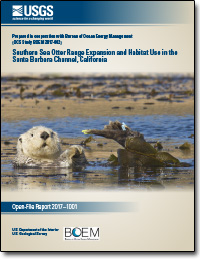Southern sea otter range expansion and habitat use in the Santa Barbara Channel, California
Links
- Document: Report (7.5 MB pdf)
- Download citation as: RIS | Dublin Core
Abstract
The re-colonization of the Santa Barbara channel by sea otters brings these ESA-listed marine mammals closer to active oil and gas production facilities, shipping lanes and naturally occurring oil and gas seeps. However, the degree to which sea otters may actually be affected by human-caused oil spills or exposure to natural oil seeps is currently unknown. Between 2012 and 2014, the U.S. Geological Survey and collaborating agencies conducted a telemetry-based study of sea otters in Santa Barbara channel, in order to provide critical information for resource managers (specifically the Bureau of Ocean Energy Management, henceforth BOEM, and the U.S. Fish and Wildlife Service, henceforth USFWS) about the spatial ecology, population status, and potential population threats to sea otters in Santa Barbara Channel, with particular reference to exposure to manmade structures and sources of oil and natural gas. Analysis of spatial monitoring data using a Bayesian-based synoptic model allowed for description of sea otter home ranges, identification of hot-spots of use, and insights into habitat selection behavior by male and female sea otters. Important findings included the deeper modal depth preferred by males versus females, strong preferences by both sexes for areas with persistent kelp canopy, and greater use of soft-sediment areas by males. The synoptic model also provided the ability to predict population-level density distribution for each sex in new habitats: by calculating the value of these probability density distributions at the known locations of natural seeps, we were able to identify those seeps with higher potential for sea otter encounters. The relative probability of occurrence at locations near to some seeps was sufficiently high (about 1% likelihood of occurrence for some of our study animals) that one would anticipate occasional encounters. Data on male and female survival, reproductive success, activity budgets, and body condition all indicated that sea otters in Santa Barbara Channel are not resource limited, and thus we would expect to see continued strong population growth in this area. However, the principal cause of death for study animals was lethal bites by white sharks, suggesting that shark bite mortality represents the single biggest threat to continued population growth in the Santa Barbara Channel.
Suggested Citation
Tinker, M.T., Tomoleoni, Joseph, LaRoche, Nicole, Bowen, Lizabeth, Miles, A. Keith, Murray, Mike, Staedler, Michelle, and Randell, Zach, 2017, Southern sea otter range expansion and habitat use in the Santa Barbara Channel, California: U.S. Geological Survey Open-File Report 2017–1001 (OCS Study BOEM 2017-002), 76 p., https://doi.org/10.3133/ofr20171001.
ISSN: 2331-1258 (online)
Study Area
Table of Contents
- Abstract
- Introduction
- Methods
- Results
- Discussion
- Acknowledgments
- References Cited
- Appendix A. Analytical Methods for Dive Behavior and Time-Activity Budgets
| Publication type | Report |
|---|---|
| Publication Subtype | USGS Numbered Series |
| Title | Southern sea otter range expansion and habitat use in the Santa Barbara Channel, California |
| Series title | Open-File Report |
| Series number | 2017-1001 |
| DOI | 10.3133/ofr20171001 |
| Publication Date | January 17, 2017 |
| Year Published | 2017 |
| Language | English |
| Publisher | U.S. Geological Survey |
| Publisher location | Reston, VA |
| Contributing office(s) | Western Ecological Research Center |
| Description | vi, 76 p. |
| Country | United States |
| State | California |
| Other Geospatial | Santa Barbara Channel |
| Online Only (Y/N) | Y |


